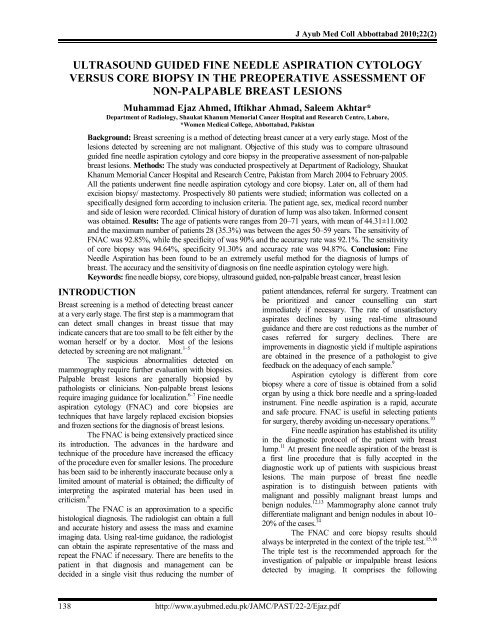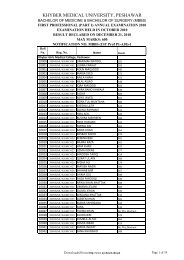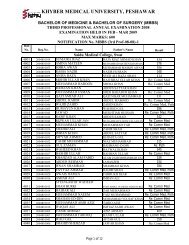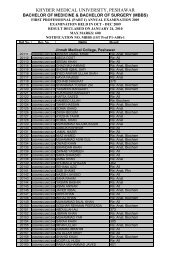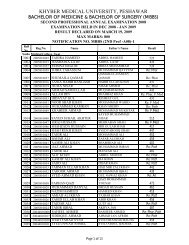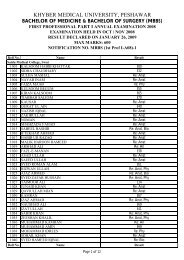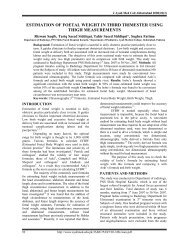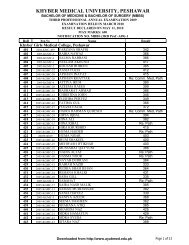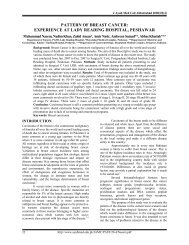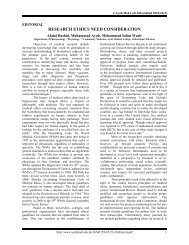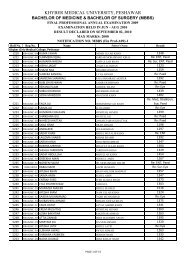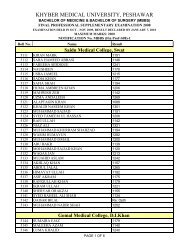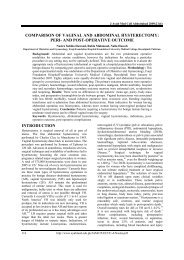ultrasound guided fine needle aspiration cytology versus core
ultrasound guided fine needle aspiration cytology versus core
ultrasound guided fine needle aspiration cytology versus core
Create successful ePaper yourself
Turn your PDF publications into a flip-book with our unique Google optimized e-Paper software.
J Ayub Med Coll Abbottabad 2010;22(2)<br />
ULTRASOUND GUIDED FINE NEEDLE ASPIRATION CYTOLOGY<br />
VERSUS CORE BIOPSY IN THE PREOPERATIVE ASSESSMENT OF<br />
NON-PALPABLE BREAST LESIONS<br />
Muhammad Ejaz Ahmed, Iftikhar Ahmad, Saleem Akhtar*<br />
Department of Radiology, Shaukat Khanum Memorial Cancer Hospital and Research Centre, Lahore,<br />
*Women Medical College, Abbottabad, Pakistan<br />
Background: Breast screening is a method of detecting breast cancer at a very early stage. Most of the<br />
lesions detected by screening are not malignant. Objective of this study was to compare <strong>ultrasound</strong><br />
<strong>guided</strong> <strong>fine</strong> <strong>needle</strong> <strong>aspiration</strong> <strong>cytology</strong> and <strong>core</strong> biopsy in the preoperative assessment of non-palpable<br />
breast lesions. Methods: The study was conducted prospectively at Department of Radiology, Shaukat<br />
Khanum Memorial Cancer Hospital and Research Centre, Pakistan from March 2004 to February 2005.<br />
All the patients underwent <strong>fine</strong> <strong>needle</strong> <strong>aspiration</strong> <strong>cytology</strong> and <strong>core</strong> biopsy. Later on, all of them had<br />
excision biopsy/ mastectomy. Prospectively 80 patients were studied; information was collected on a<br />
specifically designed form according to inclusion criteria. The patient age, sex, medical record number<br />
and side of lesion were recorded. Clinical history of duration of lump was also taken. Informed consent<br />
was obtained. Results: The age of patients were ranges from 20–71 years, with mean of 44.31±11.002<br />
and the maximum number of patients 28 (35.3%) was between the ages 50–59 years. The sensitivity of<br />
FNAC was 92.85%, while the specificity of was 90% and the accuracy rate was 92.1%. The sensitivity<br />
of <strong>core</strong> biopsy was 94.64%, specificity 91.30% and accuracy rate was 94.87%. Conclusion: Fine<br />
Needle Aspiration has been found to be an extremely useful method for the diagnosis of lumps of<br />
breast. The accuracy and the sensitivity of diagnosis on <strong>fine</strong> <strong>needle</strong> <strong>aspiration</strong> <strong>cytology</strong> were high.<br />
Keywords: <strong>fine</strong> <strong>needle</strong> biopsy, <strong>core</strong> biopsy, <strong>ultrasound</strong> <strong>guided</strong>, non-palpable breast cancer, breast lesion<br />
INTRODUCTION<br />
Breast screening is a method of detecting breast cancer<br />
at a very early stage. The first step is a mammogram that<br />
can detect small changes in breast tissue that may<br />
indicate cancers that are too small to be felt either by the<br />
woman herself or by a doctor. Most of the lesions<br />
detected by screening are not malignant. 1–5<br />
The suspicious abnormalities detected on<br />
mammography require further evaluation with biopsies.<br />
Palpable breast lesions are generally biopsied by<br />
pathologists or clinicians. Non-palpable breast lesions<br />
require imaging guidance for localization. 6–7 Fine <strong>needle</strong><br />
<strong>aspiration</strong> <strong>cytology</strong> (FNAC) and <strong>core</strong> biopsies are<br />
techniques that have largely replaced excision biopsies<br />
and frozen sections for the diagnosis of breast lesions.<br />
The FNAC is being extensively practiced since<br />
its introduction. The advances in the hardware and<br />
technique of the procedure have increased the efficacy<br />
of the procedure even for smaller lesions. The procedure<br />
has been said to be inherently inaccurate because only a<br />
limited amount of material is obtained; the difficulty of<br />
interpreting the aspirated material has been used in<br />
criticism. 8 The FNAC is an approximation to a specific<br />
histological diagnosis. The radiologist can obtain a full<br />
and accurate history and assess the mass and examine<br />
imaging data. Using real-time guidance, the radiologist<br />
can obtain the aspirate representative of the mass and<br />
repeat the FNAC if necessary. There are benefits to the<br />
patient in that diagnosis and management can be<br />
decided in a single visit thus reducing the number of<br />
patient attendances, referral for surgery. Treatment can<br />
be prioritized and cancer counselling can start<br />
immediately if necessary. The rate of unsatisfactory<br />
aspirates declines by using real-time <strong>ultrasound</strong><br />
guidance and there are cost reductions as the number of<br />
cases referred for surgery declines. There are<br />
improvements in diagnostic yield if multiple <strong>aspiration</strong>s<br />
are obtained in the presence of a pathologist to give<br />
feedback on the adequacy of each sample. 9<br />
Aspiration <strong>cytology</strong> is different from <strong>core</strong><br />
biopsy where a <strong>core</strong> of tissue is obtained from a solid<br />
organ by using a thick bore <strong>needle</strong> and a spring-loaded<br />
instrument. Fine <strong>needle</strong> <strong>aspiration</strong> is a rapid, accurate<br />
and safe procure. FNAC is useful in selecting patients<br />
for surgery, thereby avoiding un-necessary operations. 10<br />
Fine <strong>needle</strong> <strong>aspiration</strong> has established its utility<br />
in the diagnostic protocol of the patient with breast<br />
lump. 11 At present <strong>fine</strong> <strong>needle</strong> <strong>aspiration</strong> of the breast is<br />
a first line procedure that is fully accepted in the<br />
diagnostic work up of patients with suspicious breast<br />
lesions. The main purpose of breast <strong>fine</strong> <strong>needle</strong><br />
<strong>aspiration</strong> is to distinguish between patients with<br />
malignant and possibly malignant breast lumps and<br />
benign nodules. 12,13 Mammography alone cannot truly<br />
differentiate malignant and benign nodules in about 10–<br />
20% of the cases. 14<br />
The FNAC and <strong>core</strong> biopsy results should<br />
always be interpreted in the context of the triple test. 15,16<br />
The triple test is the recommended approach for the<br />
investigation of palpable or impalpable breast lesions<br />
detected by imaging. It comprises the following<br />
138<br />
http://www.ayubmed.edu.pk/JAMC/PAST/22-2/Ejaz.pdf
J Ayub Med Coll Abbottabad 2010;22(2)<br />
components: clinical breast examination and medical<br />
history, imaging-mammography and/or <strong>ultrasound</strong>, and<br />
non-excision biopsy, i.e., FNAC and/or <strong>core</strong> biopsy.<br />
The triple test is positive if any of the three components<br />
is positive, and negative if all the components are<br />
negative. The triple test has sensitivity (true positive<br />
rate) of 99.6%, and a specificity of 93%. 8<br />
At our institute, dedicated one-stop breast<br />
clinics are run using multi-disciplinary approach. Fine<br />
<strong>needle</strong> <strong>aspiration</strong> <strong>cytology</strong> offers quick preliminary<br />
diagnosis, results in early diagnosis and management of<br />
breast cancers.<br />
The process of assessment of significant breast<br />
lesions involves the correlation of clinical imaging and<br />
the cytological/histological findings. This is best<br />
achieved with a multidisciplinary open forum with the<br />
clinician, radiologist and pathologist reaching a<br />
consensus on the management of each case using<br />
prede<strong>fine</strong>d protocols. The highest levels of diagnostic<br />
accuracy are achieved if such a triple approach of<br />
imaging, clinical diagnosis and biopsy is used. If the<br />
<strong>cytology</strong> is negative in the face of strong clinical or<br />
radiological evidence of malignancy the <strong>core</strong> biopsy<br />
should be performed.<br />
In cases where cancer is reported, such an<br />
approach allows for preoperative counselling of the<br />
woman regarding treatment options, and may assist in<br />
the planning of single-stage surgery. 6,17,18 In cases where<br />
a benign diagnosis is reported or confirmed the need for<br />
excision biopsy is eliminated, the woman can be<br />
reassured and appropriate management options<br />
discussed.<br />
The advantages of this approach includes<br />
improved diagnostic accuracy in breast disease, the<br />
preoperative diagnosis of cancer, the proportion of<br />
excision biopsies for diagnostic purposes, and<br />
proportion of benign excision biopsies for diagnostic<br />
purposes.<br />
The main problem with FNAC is inadequate<br />
sampling which may be caused by the small size of the<br />
lesion. Objective of this study was to compare the<br />
accuracy of results of FNAC and <strong>core</strong> biopsy in nonpalpable<br />
breast lesion.<br />
MATERIAL AND METHODS<br />
This Comparative Diagnostic Procedure Study was<br />
carried out at Department of Radiology, Shaukat<br />
Khanum Memorial Cancer Hospital and Research<br />
Centre, Lahore from March 2004 to February 2005.<br />
All women referred for breast biopsy to<br />
Radiology Department with a suspicious lesion on<br />
mammogram or <strong>ultrasound</strong> were included in the study.<br />
Women with a previous diagnosis of breast<br />
cancer, having a primary malignancy other than breast<br />
cancer, and lesions not visualised on <strong>ultrasound</strong> were<br />
excluded from the study.<br />
All the patients underwent <strong>fine</strong> <strong>needle</strong><br />
<strong>aspiration</strong> <strong>cytology</strong> and <strong>core</strong> biopsy. Later on all of them<br />
had excision biopsy or mastectomy. Prospectively 80<br />
patients were studied. Written informed consent was<br />
obtained. Information was collected on a proforma<br />
according to inclusion criteria. Age, sex, medical record<br />
number and side of lesion were recorded. Clinical<br />
history of duration of lump was also taken. Aseptic<br />
technique was used to minimise the risk of infection.<br />
Sterilised skin preparation was done using<br />
pyodine solution and 2% lignocaine was used as local<br />
anaesthetic agent. Usually a 21-gauge <strong>needle</strong> was used<br />
for FNAC. 10–12 MHz linear probe was used for<br />
localisation of the lesion. The skin was penetrated<br />
tangentially with a long <strong>needle</strong>. All biopsies were<br />
performed using direct visualisation by <strong>ultrasound</strong>. All<br />
FNAC slides were reported by the experienced cytopathologists<br />
and <strong>core</strong> biopsies by the histopathologists.<br />
Criteria for adequacy<br />
There should be at least six clusters of ductal cells on<br />
each smear comprising 10 cells per cluster. At least 2–3<br />
passes are made from the lump from all aspects.<br />
Cytology reporting was based on the following<br />
NHS guidelines: C1=Not representative of the lesion,<br />
C2=Benign, C3=Borderline Benign, C4=Malignant/<br />
suspicious for malignancy, and C5=Malignant<br />
Criteria for malignancy<br />
The morphological characteristics that were employed<br />
to distinguish benign from malignant cells are given<br />
below: 19<br />
i) Abnormal grouping of cells, ii) Decreased mutual<br />
adhesiveness, iii) Presence of alien or foreign cells, iv)<br />
Changes in the nucleus, v) Increased/abnormal mitoses,<br />
vi) Variation in size and shape of cells, and vii)<br />
Abnormal cytoplasmic inclusions.<br />
SPSS-11.0 was used for data analysis. Master<br />
data sheet was developed and later on data was entered.<br />
Screening test was applied to calculate sensitivity,<br />
specificity and accuracy of test.<br />
RESULTS<br />
Eighty <strong>fine</strong> <strong>needle</strong> <strong>aspiration</strong> <strong>cytology</strong> and <strong>core</strong> biopsy<br />
specimens of patients presenting with a suspicious<br />
breast lesion were included in this study. The age range<br />
of patients was 20–71 years with mean of<br />
44.31±11.002. Maximum number of patients 28<br />
(35.3%) were between the age 50–59 years, (Table-1).<br />
Out of 80 patients 19 (23.8%) were diagnosed<br />
to have a benign aetiology on <strong>fine</strong> <strong>needle</strong> <strong>aspiration</strong><br />
<strong>cytology</strong> and 54 patients (67.5%) were given a diagnosis<br />
of malignancy (Table-2). Comparison of <strong>fine</strong> <strong>needle</strong><br />
<strong>aspiration</strong> <strong>cytology</strong> and final diagnosis made on<br />
excision biopsy showed that four cases were<br />
erroneously diagnosed as benign on <strong>fine</strong> <strong>needle</strong><br />
<strong>aspiration</strong> <strong>cytology</strong> whereas it was found to be<br />
http://www.ayubmed.edu.pk/JAMC/PAST/22-2/Ejaz.pdf 139
J Ayub Med Coll Abbottabad 2010;22(2)<br />
malignant on excision biopsy; seven cases were<br />
declared inadequate.<br />
On <strong>core</strong> biopsy, 23 (28.8%) patients were<br />
called benign and 55 (68.8%) patients were labelled to<br />
have malignancy. Two cases were non-diagnostic.<br />
Comparison of <strong>core</strong> biopsy and final diagnosis on<br />
excision biopsy was made (Table-3). The results were<br />
comparable apart from four cases. Two were nondiagnostic<br />
and two were erroneously labelled as<br />
malignant as there was no residual malignant tissue on<br />
excision biopsy.<br />
The validity of screening test was calculated<br />
by sensitivity, specificity and accuracy. The sensitivity<br />
of FNAC was 92.85%. The specificity of FNAC was<br />
90% and the accuracy rate was 92.1%. The sensitivity of<br />
<strong>core</strong> biopsy was 94.64%, specificity was 91.30% and<br />
accuracy rate was 94.87%.<br />
Table-1: Age distribution of the subjects<br />
Age (Year) Number Percentage<br />
20–29 6 7.6<br />
30–39 22 27.7<br />
40–49 18 22.6<br />
50–59 28 35.3<br />
60–69 4 5.2<br />
≥70 2 2.5<br />
Mean±SD 44.31±11.002<br />
Table-2: FNAC vs final diagnosis<br />
FNAC Final Diagnosis<br />
Finding Number % Number %<br />
Benign 19 23.8 23 28.8<br />
Malignant 54 67.5 57 71.3<br />
Inadequate 7 8.8 - -<br />
Total 80 100.0 80 100.0<br />
Table-3: Core vs final diagnosis<br />
Core<br />
Final diagnosis<br />
Finding Number % Number %<br />
Benign 23 28.8 23 26.0<br />
Malignant 55 68.8 57 74.0<br />
Non-diagnostic 2 2.5 - -<br />
Total 80 100 80 100.0<br />
DISCUSSION<br />
For decades, small samples of tissue have been obtained<br />
using a <strong>needle</strong> to diagnose lesions in many anatomical<br />
locations. 20 Breast lesions were identified as particularly<br />
suitable for the technique due to their accessibility. 20<br />
The use of smears obtained by <strong>aspiration</strong> for diagnostic<br />
purposes was reported as early as 1933, when Stewart’s<br />
series of 2,500 specimens included almost 500 breast<br />
lesions. 21 Breast changes can be detected as a<br />
mammographic lesion at screening, as a breast symptom<br />
found by the woman or as a sign found by her doctor.<br />
The investigation of these changes using the triple test<br />
approach will often involve FNAC or <strong>core</strong> biopsy to<br />
help determine the nature of the lesion.<br />
The FNAC and <strong>core</strong> biopsy were originally<br />
used to diagnose palpable breast lesions. Both methods<br />
have a high degree of sensitivity and specificity. The<br />
FNAC is an excellent method for diagnosing palpable<br />
lesions; its sensitivity has been reported to be between<br />
89% and 98% 5 and its specificity between 98% and<br />
100%. 22 Following the introduction of mammographic<br />
screening, FNAC and <strong>core</strong> biopsy are now also used to<br />
diagnose impalpable breast lesions. The sensitivity and<br />
specificity of stereotactic FNAC with impalpable<br />
lesions have been reported to be 77–100% and 91–<br />
100% respectively. 22 The use of <strong>core</strong> biopsy has<br />
increased, especially in the evaluation of lesions that<br />
are associated with high inadequacy rates with FNAC<br />
such as mammographically or sonographically<br />
detected lesions that are very small, suspected radial<br />
scars or microcalcifications. 22 Both the sensitivity and<br />
specificity of <strong>core</strong> biopsy for the diagnosis of<br />
impalpable lesions are usually reported to be at least<br />
90%. 20 In a multidisciplinary breast setting it has been<br />
shown that <strong>ultrasound</strong>-<strong>guided</strong> <strong>core</strong> biopsy has a<br />
sensitivity of 82% and a specificity and a positive<br />
predictive value (PPV) for malignancy of 100%. In<br />
general, <strong>core</strong> biopsy has been shown to be superior for<br />
the confirmation of benign lesions, as the rate of<br />
samples reported as unsatisfactory is less than for<br />
FNAC (12.5% <strong>versus</strong> 34.2%).<br />
Although several studies have demonstrated a<br />
high degree of diagnostic accuracy in breast cancer with<br />
<strong>aspiration</strong> <strong>cytology</strong> 17,23 its role in the management of<br />
breast lesions is still controversial. 15 Many surgeons are<br />
reluctant to consider positive <strong>cytology</strong> results as the only<br />
criterion for performing definitive surgery 11,12,24,25 since<br />
no distinction is possible between infiltrating and noninfiltrating<br />
lesions. In some studies they use surgical<br />
biopsy to confirm cytologically negative and suspicious<br />
cases and directly operate only on those cases with<br />
positive cytologic diagnosis. 11,24<br />
In the UK, 62% of cancers detected in 1996–<br />
1997 in the National Health Service Breast Screening<br />
Program were diagnosed preoperatively by FNAC or<br />
<strong>core</strong> biopsy. 23 Even though this is still short of the<br />
National Health Service Breast Screening Program<br />
target of 70%, however it is argued that it represents an<br />
improvement over previous years, and an improvement<br />
that is likely to continue as a result of improved<br />
technological expertise by the radiographers,<br />
radiologists and pathologists involved.<br />
When the UK National Health Service Breast<br />
Screening Program was established, FNAC was the<br />
method of choice in the assessment of image- detected<br />
lesions. However, in recent years there has been an<br />
increase in the use of <strong>core</strong> biopsies to facilitate a<br />
preoperative diagnosis. 23 There are two principal<br />
explanations for this trend. One is the increased rate of<br />
inadequate specimens in impalpable lesions, sampled by<br />
140<br />
http://www.ayubmed.edu.pk/JAMC/PAST/22-2/Ejaz.pdf
J Ayub Med Coll Abbottabad 2010;22(2)<br />
FNAC. The other is the lack of expertise among<br />
pathologists in the interpretation of <strong>fine</strong> <strong>needle</strong> aspirates.<br />
FNAC and <strong>core</strong> biopsy are complementary<br />
procedures. The studies found that there is insufficient<br />
evidence to decide if one method is better than another.<br />
These authors recommend the use of the appropriate<br />
combination of FNAC and/or <strong>core</strong> biopsy as the best<br />
approach for the diagnosis of breast lesions at different<br />
settings. 17,26<br />
In this study we found out that <strong>fine</strong> <strong>needle</strong><br />
<strong>aspiration</strong> <strong>cytology</strong> from predominant number of<br />
patients had similar results as compared to <strong>core</strong> biopsy<br />
and then results were comparable to the final diagnosis<br />
on excision biopsy.<br />
In some of the cases immunohistochemical<br />
stains were required to reach a definite diagnosis, <strong>core</strong><br />
biopsies were helpful for obtaining tissue. Smooth<br />
muscle action (SMA) IHC stain was used in few cases<br />
for the demonstration of myoepithelial layer for<br />
diagnosis of benignity of a lesion.<br />
A five category system for reporting of<br />
<strong>cytology</strong> of breast has been found very useful. 26 We<br />
come across two groups of lesions, i.e., benign and<br />
suspicious for benign and malignant and suspicious for<br />
malignancy. First a considerable number of the <strong>cytology</strong><br />
samples were termed inadequate because it did not<br />
represent the lesion as seen on mammography.<br />
However, we also encountered problems when <strong>needle</strong><br />
<strong>aspiration</strong> were done from areas with microcalcification<br />
and fibrosis 27 as the yield was much less and non<br />
diagnostic. Another problem we faced during the study<br />
was cases falling in the grey zone that were benign but<br />
suspicious; these included proliferative breast disease<br />
that may mimic carcinoma on <strong>cytology</strong>. 28 Some of these<br />
are essentially benign but require <strong>core</strong> biopsy to exclude<br />
associated malignancy.<br />
Our series contained a small (6.25%)<br />
population of inadequate cases. In a similar study a 10%<br />
inadequacy rate has been reported. 29 Furthermore unlike<br />
our study, that study calculated the sensitivity and<br />
specificity after excluding the inadequate cases. 35 If we<br />
were to combine the data gained from radiological<br />
assessment, breast FNAC and <strong>needle</strong> <strong>core</strong> biopsy there<br />
would be no false negative cases and both sensitivity<br />
and specificity would rise to 100%. This also illustrates<br />
the requirement of good clinico-pathological correlation<br />
and further regular multidisciplinary meetings before<br />
further treatment is planned.<br />
CONCLUSION<br />
Fine-<strong>needle</strong> <strong>aspiration</strong> has been found to be an<br />
extremely useful method for the diagnosis of lumps of<br />
breast. The accuracy and sensitivity of diagnosis on <strong>fine</strong><br />
<strong>needle</strong> <strong>aspiration</strong> <strong>cytology</strong> was high. Although a number<br />
of inadequate cases preclude a definitive role as<br />
compared to <strong>core</strong> biopsy, we suggest that there are<br />
advantages in combining <strong>fine</strong> <strong>needle</strong> <strong>aspiration</strong><br />
<strong>cytology</strong>, clinical impression and imaging findings to<br />
reach to a definitive diagnosis.<br />
REFERENCES<br />
1. Silverstein MJ, Gamagami P, Colburn WJ, Gierson<br />
ED, Rosser RJ, Handel N, et al. Nonpalpable breast<br />
lesions: diagnosis with slightly overpenetrated screen-film<br />
mammography and hook wire-directed biopsy in 1014 cases.<br />
Radiology 1989;171:633–8.<br />
2. Alexander HR, Candela FC, Dershaw DD, Kinne DW.<br />
Needle-localized mammographic lesions: results and<br />
evolving treatment strategy. Arch Surg 1990;125:1441–4.<br />
3. Layfield LJ, Parkinson B, Wong J, Giuliani AE, Basset LW.<br />
Mammographically <strong>guided</strong> <strong>fine</strong>-<strong>needle</strong> <strong>aspiration</strong> biopsy of<br />
nonpalpable breast lesions Can it replace open biopsy?<br />
Cancer 1991;68:2007–11.<br />
4. Thompson WR, Bowen JR, Dorman BA, Pricolo VE,<br />
Shahinian TK, Soderberg CH. Mammographic localization<br />
and biopsy of nonpalpable breast lesions. Arch Surg<br />
1991;126:730–4.<br />
5. Fajardo LL, Pisano ED, Caudry DJ, Gatsonis CA, Berg<br />
WA, Connolly J, et al. Stereotactic and sonographic large<strong>core</strong><br />
biopsy of nonpalpable breast lesions. Acad Radiol<br />
2004;11:293–308.<br />
6. Apestegu ´a L, Pina L, Inchusta M, Mellado M, Franquet<br />
T, De Miguel C, et al. Nonpalpable, well-de<strong>fine</strong>d, probably<br />
benign breast nodule: management by <strong>fine</strong>-<strong>needle</strong> <strong>aspiration</strong><br />
biopsy and long-interval follow-up mammography. Eur<br />
Radiol 1997;7:1235–9.<br />
7. Thurfjell E. Mammographically-<strong>guided</strong> <strong>fine</strong> <strong>needle</strong> <strong>aspiration</strong><br />
in differential diagnosis of cystic <strong>versus</strong> solid rounded<br />
masses smaller than 2 cm detected at mammographic<br />
screening. Breast Cancer Res Treat 2002;75:221–6.<br />
8. Frable WJ. Thin <strong>needle</strong> <strong>aspiration</strong> biopsy. Philadelphia: WB<br />
Saunders Co; 1983. p.1–71.<br />
9. Pennes DR, Naylor B, Rebner M. Fine <strong>needle</strong> <strong>aspiration</strong><br />
biopsy of the breast. Influence of the number of passes and<br />
the sample size on the diagnostic yield. Acta Cytologica<br />
1990;34:673–6.<br />
10. Bibbo M. Scheiber M, Cajulis R, Keebler CM, Wied<br />
GL, Dowlatshahi K. Stereotaxic <strong>fine</strong> <strong>needle</strong> <strong>aspiration</strong><br />
<strong>cytology</strong> of clinically occult malignant and premalignant<br />
breast lesions. Acta Cytol 1988;32:193–201.<br />
11. Das DK, Sodhani P, Kashyap V, Parkash S, Pant<br />
JN, Bhatnagar P. Inflammatory Lesions of the Breast:<br />
Diagnosis by Fine Needle Aspiration. Cytopathology<br />
1992;3(5):281–9.<br />
12. Dejmek A, Lindholm K. Frequency of Cytologic features in<br />
<strong>fine</strong> <strong>needle</strong> aspirates from histologically and cytologically<br />
diagnosed fibroadenomas. Acta Cytol 1991;35:695–9.<br />
13. Bottles K, Chan JS, Holly EA, Chiu SH, Miller TR.<br />
Cytology criteria for fibroadenoma: A step-wise logistic<br />
regression analysis. Am J Clin Pathol 1988;89:707–9.<br />
14. Bright RA, Morrison AS, Brisson J. Burstein<br />
NA, Sadowsky NL, Kopans DB, et al. Histologic and<br />
mammographic specificity of risk factors for benign breast<br />
disease. Cancer 1989;64:653–7.<br />
15. Garre Sánchez MC, Sola Pérez J, Bas Bernal<br />
A, Mercader Martínez J, López Alanis A. Ultrasound<br />
<strong>guided</strong> <strong>fine</strong> <strong>needle</strong> <strong>aspiration</strong> biopsy. Study of the cost per<br />
patient and comparison with computed tomograpgy <strong>guided</strong><br />
biopsy. Rev ESP Enferm Diag 1997;89:297–304.<br />
16. Collacol M, deLima RS, Werner B, Torres IFB. Value of <strong>fine</strong><br />
<strong>needle</strong> <strong>aspiration</strong> in the diag of breast lesions. Acta Cyto<br />
1999;43:587–92.<br />
17. Alderson MR, Hamlin I, Staunton MD. The relative<br />
significance of prognostic factors in breast carcinomas. Br J<br />
Cancer 1971;25:646–56.<br />
http://www.ayubmed.edu.pk/JAMC/PAST/22-2/Ejaz.pdf 141
J Ayub Med Coll Abbottabad 2010;22(2)<br />
18. Howat AJ, Hoda RS. Correspondence. Why pathologists<br />
should take <strong>needle</strong> <strong>aspiration</strong> specimens. Cytopathology<br />
1995;6:419–20.<br />
19. Wells CA, Ellis I. O, Zakhour HD, Wilson AR. Cytology<br />
subgroup of the national coordinating committee for breast<br />
cancer screening pathology. Guidelines for <strong>cytology</strong><br />
procedures and reporting of <strong>fine</strong> <strong>needle</strong> aspirates of the<br />
breast. Cytopathology 1994;5;316–34.<br />
20. Abele AS, Miller TR, Goodson WH 3 rd , Hunt TK, Hohn<br />
DC. Fine <strong>needle</strong> <strong>aspiration</strong> of palpable breast masses: A<br />
Program for staged implementation. Arch Surg<br />
1983;118:859–63.<br />
21. Rimm DL, Stastny J, Rimm EB, Ayer S, Frable WJ.<br />
Comparison of the costs of <strong>fine</strong> <strong>needle</strong> <strong>aspiration</strong> and open<br />
surgical biopsy as methods for obtaining a pathological<br />
diagnosis. Cancer 1997;81:51–6.<br />
22. Adye B, Jolly PC, Bauermeister DE. The role of <strong>fine</strong>-<strong>needle</strong><br />
<strong>aspiration</strong> in the management of solid breast masses. Arch<br />
Surg 1988;123:37–9.<br />
23. Dixon JM, Clarke PJ, Crucioli Vl. Dehn TC, Lee<br />
EC, Greenall MJ. Reduction of the surgical excision rate in<br />
bening breast disease using <strong>fine</strong> <strong>needle</strong> <strong>aspiration</strong> <strong>cytology</strong><br />
with immediate reporting. Br J Surg 1987;74:1014–6.<br />
24. Quershi N, Usman N. Comparison of <strong>fine</strong> <strong>needle</strong> <strong>aspiration</strong><br />
<strong>cytology</strong> with histology in palpable breast lesions. Biomedica<br />
1998;14:98–100.<br />
25. Bodó M, Döbrössy L, Sugár I, Boeck’s sarcoidosis of the<br />
Breast: Cytologic findings with <strong>aspiration</strong> biopsy <strong>cytology</strong>: a<br />
case clinically mimicking carcinoma: Acta Cytol 1978;22:1–2.<br />
26. National Health System Breast Screening program.<br />
Guidelines for <strong>cytology</strong> procedures and reporting in breast<br />
cancer screening. Sheffield: NHSBSP publication; 1993.<br />
27. Hirst C, Davis N. Core biopsy for microcalcification in the<br />
breast. Aust N Z J Surg 1997;67:320–4.<br />
28. Schimazu K, Masana N, Yamada T, Okamoto K, Kanda K.<br />
Cytologic evaluation of phylloides tumour as compared to<br />
fiberadenoma of breast. Acta Cytol 1994;38:891–7.<br />
29. Lifrange E, Kaidelka F, Collin C. Stereotaxic <strong>needle</strong>-<strong>core</strong><br />
biopsy and <strong>fine</strong>-<strong>needle</strong> <strong>aspiration</strong> biopsy in the diagnosis of<br />
nonpalpable breast lesions: controversies and future<br />
prospects. Eur J Radiol 1997;24:39–47.<br />
Address for Correspondence:<br />
Dr Iftikhar Ahmad, Specialist Radiologist, Department of Radiology, Capital Health and Screening Centre, Abu<br />
Dhabi, UAE. Cell: +971-502686452<br />
Email: driftikharahmad@hotmail.com<br />
142<br />
http://www.ayubmed.edu.pk/JAMC/PAST/22-2/Ejaz.pdf


